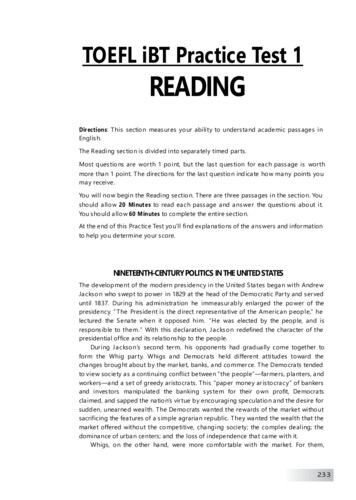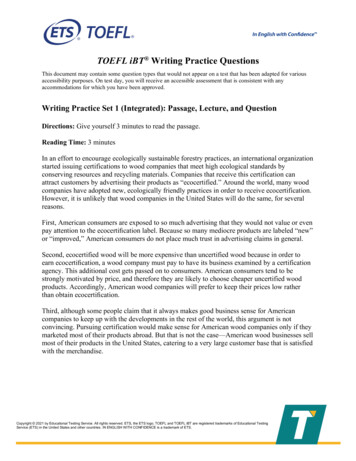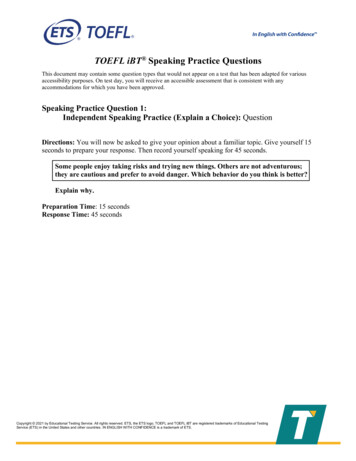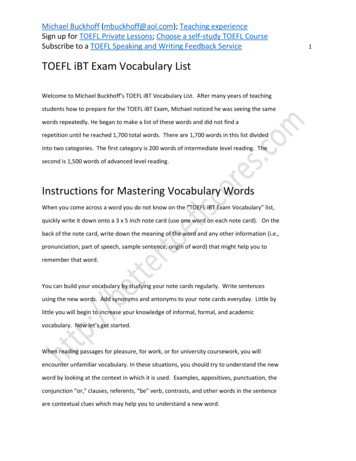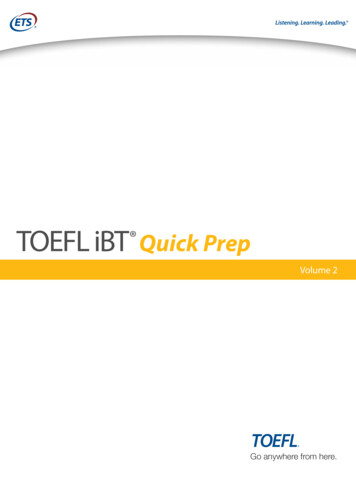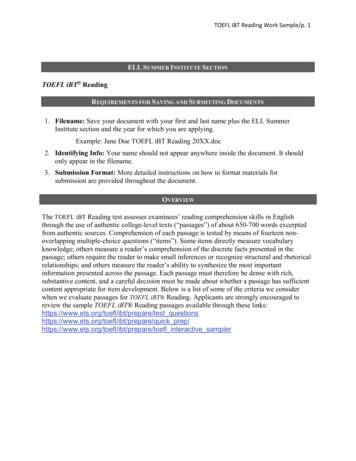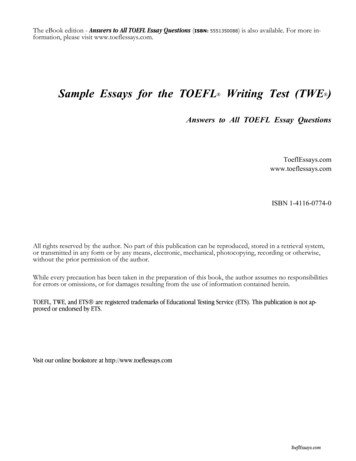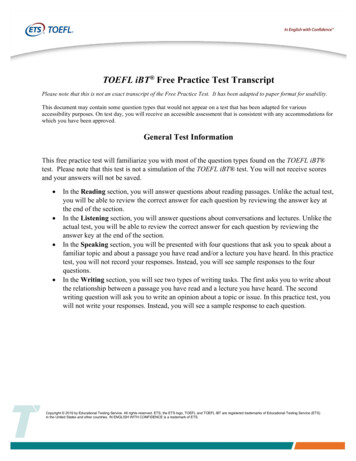
Transcription
TOEFL iBT Free Practice Test TranscriptPlease note that this is not an exact transcript of the Free Practice Test. It has been adapted to paper format for usability.This document may contain some question types that would not appear on a test that has been adapted for variousaccessibility purposes. On test day, you will receive an accessible assessment that is consistent with any accommodations forwhich you have been approved.General Test InformationThis free practice test will familiarize you with most of the question types found on the TOEFL iBT test. Please note that this test is not a simulation of the TOEFL iBT test. You will not receive scoresand your answers will not be saved. In the Reading section, you will answer questions about reading passages. Unlike the actual test,you will be able to review the correct answer for each question by reviewing the answer key atthe end of the section.In the Listening section, you will answer questions about conversations and lectures. Unlike theactual test, you will be able to review the correct answer for each question by reviewing theanswer key at the end of the section.In the Speaking section, you will be presented with four questions that ask you to speak about afamiliar topic and about a passage you have read and/or a lecture you have heard. In this practicetest, you will not record your responses. Instead, you will see sample responses to the fourquestions.In the Writing section, you will see two types of writing tasks. The first asks you to write aboutthe relationship between a passage you have read and a lecture you have heard. The secondwriting question will ask you to write an opinion about a topic or issue. In this practice test, youwill not write your responses. Instead, you will see a sample response to each question.Copyright 2019 by Educational Testing Service. All rights reserved. ETS, the ETS logo, TOEFL and TOEFL iBT are registered trademarks of Educational Testing Service (ETS)in the United States and other countries. IN ENGLISH WITH CONFIDENCE is a trademark of ETS.
Reading Section DirectionsThe Reading section of the TOEFL iBT test measures your ability to understand academic passageswritten in English.In the actual test, each passage in the Reading section is followed by 9 OR 10 questions about thatpassage. You will read three or four passages and answer the questions. If you receive three passages,you will have 54 minutes to read the passages and answer the questions. If you receive four passages,you will have 72 minutes to respond. In this practice test, you will answer questions about threepassages.Most questions in the Reading section are worth one point, but the last question in each set is worthmore than one point. The directions indicate how many points you can receive. Some passages include aword or phrase that is underlined in blue. Choose the word or phrase to see a definition or explanation.You can skip questions and go back later. You can review the correct answer for each question byreviewing the answer key at the end of the section at any time.Copyright 2019 by Educational Testing Service. All rights reserved. ETS, the ETS logo, TOEFL and TOEFL iBT are registered trademarks of Educational Testing Service (ETS) in theUnited States and other countries. IN ENGLISH WITH CONFIDENCE is a trademark of ETS.
Reading Practice Set 1Agriculture, Iron, and the Bantu Peoples1.There is evidence of agriculture in Africa prior to 3000 B.C. It may have developedindependently, but many scholars believe that the spread of agriculture and iron throughoutAfrica linked it to the major centers of the Near East and Mediterranean world. The drying upof what is now the Sahara desert had pushed many peoples to the south into sub-SaharanAfrica. These peoples settled at first in scattered hunting-and-gathering bands, although insome places near lakes and rivers, people who fished, with a more secure food supply, livedin larger population concentrations. Agriculture seems to have reached these people from theNear East, since the first domesticated crops were millets and sorghums whose origins are notAfrican but West Asian. Once the idea of planting diffused, Africans began to develop theirown crops, such as certain varieties of rice, and they demonstrated a continued receptivenessto new imports. The proposed areas of the domestication of African crops lie in a band thatextends from Ethiopia across southern Sudan to West Africa. Subsequently, other crops, suchas bananas, were introduced from Southeast Asia.2.Livestock also came from outside Africa. Cattle were introduced from Asia, as probably weredomestic sheep and goats. Horses were apparently introduced by the Hyksos invaders ofEgypt (1780–1560 B.C.) and then spread across the Sudan to West Africa. Rock paintings inthe Sahara indicate that horses and chariots were used to traverse the desert and that by 300–200 B.C., there were trade routes across the Sahara. Horses were adopted by peoples of theWest African savannah, and later their powerful cavalry forces allowed them to carve outlarge empires. Finally, the camel was introduced around the first century A.D. This was animportant innovation, because the camel’s ability to thrive in harsh desert conditions and tocarry large loads cheaply made it an effective and efficient means of transportation. Thecamel transformed the desert from a barrier into a still difficult, but more accessible, route oftrade and communication.3.Iron came from West Asia, although its routes of diffusion were somewhat different thanthose of agriculture. Most of Africa presents a curious case in which societies moved directlyfrom a technology of stone to iron without passing through the intermediate stage of copperor bronze metallurgy, although some early copper-working sites have been found in WestAfrica. Knowledge of iron making penetrated into the forests and savannahs of West Africa atroughly the same time that iron making was reaching Europe. Evidence of iron making hasbeen found in Nigeria, Ghana, and Mali.4.This technological shift caused profound changes in the complexity of African societies. Ironrepresented power. In West Africa the blacksmith who made tools and weapons had anCopyright 2019 by Educational Testing Service. All rights reserved. ETS, the ETS logo, TOEFL and TOEFL iBT are registered trademarks of Educational Testing Service (ETS) in theUnited States and other countries. IN ENGLISH WITH CONFIDENCE is a trademark of ETS.
important place in society, often with special religious powers and functions. Iron hoes, whichmade the land more productive, and iron weapons, which made the warrior more powerful,had symbolic meaning in a number of West African societies. Those who knew the secrets ofmaking iron gained ritual and sometimes political power.5.Unlike in the Americas, where metallurgy was a very late and limited development, Africanshad iron from a relatively early date, developing ingenious furnaces to produce the high heatneeded for production and to control the amount of air that reached the carbon and iron orenecessary for making iron. Much of Africa moved right into the Iron Age, taking the basictechnology and adapting it to local conditions and resources.6.The diffusion of agriculture and later of iron was accompanied by a great movement ofpeople who may have carried these innovations. These people probably originated in easternNigeria. Their migration may have been set in motion by an increase in population caused bya movement of peoples fleeing the desiccation, or drying up, of the Sahara. They spoke alanguage, proto-Bantu (“bantu” means “the people”), which is the parent tongue of a largenumber of Bantu languages still spoken throughout sub-Saharan Africa. Why and how thesepeople spread out into central and southern Africa remains a mystery, but archaeologistsbelieve that their iron weapons allowed them to conquer their hunting-gathering opponents,who still used stone implements. Still, the process is uncertain, and peaceful migration—orsimply rapid demographic growth—may have also caused the Bantu explosion.Copyright 2019 by Educational Testing Service. All rights reserved. ETS, the ETS logo, TOEFL and TOEFL iBT are registered trademarks of Educational Testing Service (ETS) in theUnited States and other countries. IN ENGLISH WITH CONFIDENCE is a trademark of ETS.
Directions: Now answer the questions.1.According to paragraph 1, why do researchers doubt that agriculture developed independently inAfrica?(A)(B)(C)(D)2.African lakes and rivers already provided enough food for people to survive without agriculture.The earliest examples of cultivated plants discovered in Africa are native to Asia.Africa’s native plants are very difficult to domesticate.African communities were not large enough to support agriculture.In paragraph 1, what does the author imply about changes in the African environment during thistime period?(A) The climate was becoming milder, allowing for a greater variety of crops to be grown.(B) Although periods of drying forced people south, they returned once their food supply wassecure.(C) Population growth along rivers and lakes was dramatically decreasing the availability of fish.(D) A region that had once supported many people was becoming a desert where few could survive.3.According to paragraph 2, camels were important because they(A)(B)(C)(D)were the first domesticated animal to be introduced to Africaallowed the people of the West African savannahs to carve out large empireshelped African peoples defend themselves against Egyptian invadersmade it cheaper and easier to cross the Sahara4.The word “profound” in the passage is closest in meaning to(A) fascinating(B) far-reaching(C) necessary(D) temporary5.The word “ritual” in the passage is closest in meaning opyright 2019 by Educational Testing Service. All rights reserved. ETS, the ETS logo, TOEFL and TOEFL iBT are registered trademarks of Educational Testing Service (ETS) in theUnited States and other countries. IN ENGLISH WITH CONFIDENCE is a trademark of ETS.
6.According to paragraph 4, all of the following were social effects of the new metal technology inAfrica EXCEPT:(A) Access to metal tools and weapons created greater social equality.(B) Metal weapons increased the power of warriors.(C) Iron tools helped increase the food supply.(D) Technical knowledge gave religious power to its holders.7.Which of the sentences below best expresses the essential information in the highlighted sentence inthe passage? Incorrect choices change the meaning in important ways or leave out essentialinformation.(A) While American iron makers developed the latest furnaces, African iron makers continuedusing earlier techniques.(B) Africans produced iron much earlier than Americans, inventing technologically sophisticatedheating systems.(C) Iron making developed earlier in Africa than in the Americas because of the ready availabilityof carbon and iron ore.(D) Both Africa and the Americas developed the capacity for making iron early, but Africanmetallurgy developed at a slower rate.8.Paragraph 6 mentions all of the following as possible causes of the “Bantu explosion” EXCEPT(A)(B)(C)(D)superior weaponsbetter hunting skillspeaceful migrationincreased populationCopyright 2019 by Educational Testing Service. All rights reserved. ETS, the ETS logo, TOEFL and TOEFL iBT are registered trademarks of Educational Testing Service (ETS) in theUnited States and other countries. IN ENGLISH WITH CONFIDENCE is a trademark of ETS.
9.In the paragraph below, there is a missing sentence. Look at the paragraph and indicate (A, B, Cand D) where the following sentence could be added to the passage.These people had a significant linguistic impact on the continent as well.Where would the sentence best fit?The diffusion of agriculture and later of iron was accompanied by a great movement of people whomay have carried these innovations. These people probably originated in eastern Nigeria. (A) Theirmigration may have been set in motion by an increase in population caused by a movement ofpeoples fleeing the desiccation, or drying up, of the Sahara. (B) They spoke a language, proto-Bantu(“bantu” means “the people”), which is the parent tongue of a large number of Bantu languages stillspoken throughout sub-Saharan Africa. Why and how these people spread out into central andsouthern Africa remains a mystery, but archaeologists believe that their iron weapons allowed themto conquer their hunting-gathering opponents, who still used stone implements. (C) Still, the processis uncertain, and peaceful migration—or simply rapid demographic growth—may have also causedthe Bantu explosion. (D)(A)(B)(C)(D)Option AOption BOption COption DCopyright 2019 by Educational Testing Service. All rights reserved. ETS, the ETS logo, TOEFL and TOEFL iBT are registered trademarks of Educational Testing Service (ETS) in theUnited States and other countries. IN ENGLISH WITH CONFIDENCE is a trademark of ETS.
10. Directions: An introductory sentence for a brief summary of the passage is provided below.Complete the summary by choosing the THREE answer choices that express the most importantideas in the passage. Some sentences do not belong in the summary because they express ideas thatare not presented in the passage or are minor ideas in the passage. This question is worth 2 points.Write your answer choices in the spaces where they belong. You can either write the letter of youranswer choice, or you can copy the sentence.Agriculture and iron working probably spread to Africa from neighboring regions.Answer Choices(A) Once Africans developed their own native crops, they no longer borrowed from otherregions.(B) The harshness of the African climate meant that agriculture could not develop until after theintroduction of iron tools.(C) The use of livestock improved transportation and trade an
TOEFL iBT Free Practice Test Transcript . test, you
